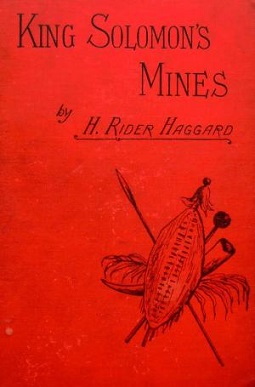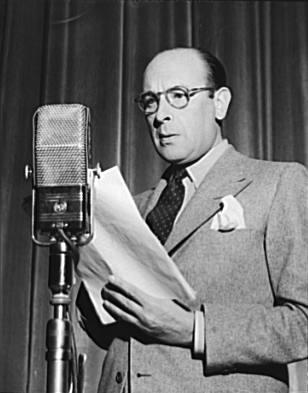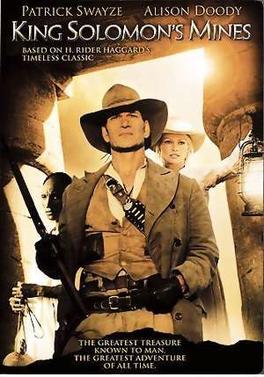
Sir Henry Rider Haggard was an English writer of adventure fiction romances set in exotic locations, predominantly Africa, and a pioneer of the lost world literary genre. He was also involved in land reform throughout the British Empire. His stories, situated at the lighter end of Victorian literature and including the eighteen Allan Quatermain stories, continue to be popular and influential.

King Solomon's Mines (1885) is a popular novel by the English Victorian adventure writer and fabulist Sir H. Rider Haggard. It tells of an expedition through an unexplored region of Africa by a group of adventurers led by Allan Quatermain, searching for the missing brother of one of the party. It is one of the first English adventure novels set in Africa and is considered to be the genesis of the lost world literary genre. It is the first of fourteen novels and four short stories by Haggard about Allan Quatermain. Haggard dedicated this book to his childhood idol Sir Humphry Davy.

Sir Cedric Webster Hardwicke was an English stage and film actor whose career spanned nearly 50 years. His theatre work included notable performances in productions of the plays of Shakespeare and Shaw, and his film work included leading roles in several adapted literary classics.

Allan Quatermain is the protagonist of H. Rider Haggard's 1885 novel King Solomon's Mines, its one sequel Allan Quatermain (1887), twelve prequel novels and four prequel short stories, totalling eighteen works. An English professional big game hunter and adventurer, in film and television he has been portrayed by Richard Chamberlain, Sean Connery, Cedric Hardwicke, Patrick Swayze and Stewart Granger among others.
Al(l)an Qua(r)termain(e) may refer to:

Allan Quatermain and the Lost City of Gold is a 1986 American adventure comedy film directed by Gary Nelson and released in West Germany on December 18, 1986, and in the United States on January 30, 1987. It is loosely based on the 1887 novel Allan Quatermain by H. Rider Haggard. It is the sequel to the 1985 film King Solomon's Mines.

Robert Edward Stevenson was a British-American screenwriter and film director.
The lost world is a subgenre of the fantasy or science fiction genres that involves the discovery of an unknown Earth civilization. It began as a subgenre of the late-Victorian adventure romance and remains popular into the 21st century.
Quartermain or Quartermaine is a surname which may refer to:

Cleopatra: Being an Account of the Fall and Vengeance of Harmachis is an adventure novel written by English author H. Rider Haggard and first printed in 1889 by Longmans. Cleopatra mixes historical action with supernatural events, and could be described as a historical fantasy novel.

John Loder was established as a British film actor in Germany and Britain before migrating to the United States in 1928 for work in the new talkies. He worked in Hollywood for two periods, becoming an American citizen in 1947. After living also in Argentina, he became a naturalized British citizen in 1959.

Watusi is a 1959 American adventure film, It is the sequel to the 1950 film King Solomon's Mines. The film was directed by Kurt Neumann and starring George Montgomery, Taina Elg, David Farrar and Rex Ingram. It was produced by Al Zimbalist and Donald Zimbalist. The screenplay was by James Clavell loosely based on the 1885 novel King Solomon's Mines by H. Rider Haggard.

King Solomon's Mines is a 1950 Technicolor adventure film, and the second film adaptation of the 1885 novel of the same name by Henry Rider Haggard. It stars Deborah Kerr, Stewart Granger and Richard Carlson. It was adapted by Helen Deutsch, directed by Compton Bennett and Andrew Marton and released by Metro-Goldwyn-Mayer.

King Solomon's Mines is a 2004 American two-part television miniseries, the fifth film adaptation of the 1885 novel of the same name by Henry Rider Haggard. Starring Patrick Swayze as Allan Quatermain and Alison Doody as Elizabeth Maitland, the film was produced by Hallmark Entertainment, and originally aired June 6, 2004, on Hallmark Channel.

King Solomon's Mines is a 1985 action adventure film, and a film adaptation of the 1885 novel of the same name by H. Rider Haggard. It stars Richard Chamberlain, Sharon Stone, Herbert Lom, and John Rhys-Davies. It was produced by Cannon Films. It was adapted by Gene Quintano and James R. Silke and directed by J. Lee Thompson. This version of the story was a light, comedic take, deliberately referring to, and parodying, the Indiana Jones film series. It was filmed outside Harare in Zimbabwe. The film was made and released exactly 100 years after the release of the novel on which the film is based.

A total lunar eclipse occurred on 1 March 1504, visible at sunset for the Americas, and later over night over Europe and Africa, and near sunrise over Asia.

King Solomon's Treasure is a 1979 British-Canadian low-budget film based on the novels King Solomon's Mines (1885) and Allan Quatermain (1887) by H. Rider Haggard. It stars John Colicos as Allan Quatermain, as well as David McCallum, Britt Ekland, and Patrick Macnee who replaced Terry-Thomas.
Allan Quatermain is an 1887 novel by H. Rider Haggard. It is the sequel to Haggard's 1885 novel King Solomon's Mines. Allan Quatermain is the second novel and fourth overall story in the eighteen-part series of the same name, though chronologically it is the final entry.
Arthur Goullet (1894–1978) was a British stage, film and television actor. He played the role of Sebastian Moran in the 1937 Sherlock Holmes film Silver Blaze.
Ita Ekpenyon (1899–1951) was a Nigerian teacher and actor who was also the only known black Air Raid Precautions (ARP) warden in the United Kingdom. Ekpenyon was a teacher in Nigeria but came to London to study law. A speaker of the Efik language, he contributed to a textbook that was used by colonial authorities in Nigeria. Ekpenyon later taught the language to American actor Paul Robeson, with whom he acted in the 1930s films Sanders of the River and King Solomon's Mines. When the Second World War broke out, being too old to serve in the military, he joined the ARP service as a warden. He recounted that some London residents regarded him as lucky because of the colour of his skin, but he also encountered casual racism. Ekpenyon witnessed foreign nationals being barred from one air raid shelter and intervened to persuade the occupants to admit the newcomers; the incident was made into an animated film in 2010. Ekpenyon wrote a memoir on his ARP service and also featured in wartime broadcasts to demonstrate the commitment of West Africans to the war effort. In 2021, a Lucy Worsley docudrama featured Ekpenyon's life. After the war, Ekpenyon gave up on his ambitions for a career in law and became a postman.














